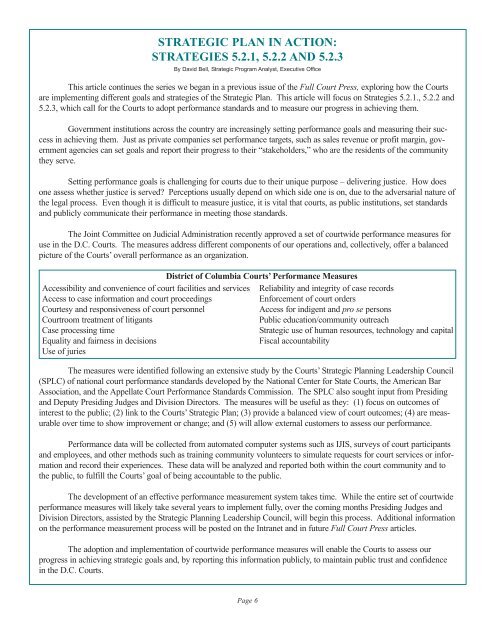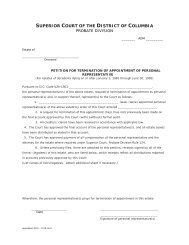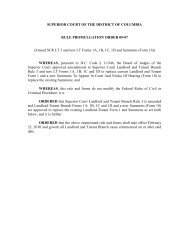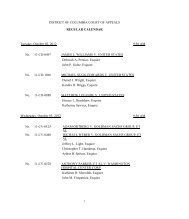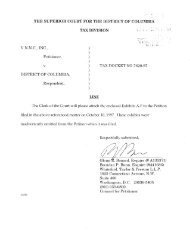MayFCP05useforPDF rev 3-18-08:Layout 1.qxd - District of ...
MayFCP05useforPDF rev 3-18-08:Layout 1.qxd - District of ...
MayFCP05useforPDF rev 3-18-08:Layout 1.qxd - District of ...
You also want an ePaper? Increase the reach of your titles
YUMPU automatically turns print PDFs into web optimized ePapers that Google loves.
STRATEGIC PLAN IN ACTION:<br />
STRATEGIES 5.2.1, 5.2.2 AND 5.2.3<br />
By David Bell, Strategic Program Analyst, Executive Office<br />
This article continues the series we began in a p<strong>rev</strong>ious issue <strong>of</strong> the Full Court Press, exploring how the Courts<br />
are implementing different goals and strategies <strong>of</strong> the Strategic Plan. This article will focus on Strategies 5.2.1., 5.2.2 and<br />
5.2.3, which call for the Courts to adopt performance standards and to measure our progress in achieving them.<br />
Government institutions across the country are increasingly setting performance goals and measuring their success<br />
in achieving them. Just as private companies set performance targets, such as sales <strong>rev</strong>enue or pr<strong>of</strong>it margin, government<br />
agencies can set goals and report their progress to their “stakeholders,” who are the residents <strong>of</strong> the community<br />
they serve.<br />
Setting performance goals is challenging for courts due to their unique purpose – delivering justice. How does<br />
one assess whether justice is served? Perceptions usually depend on which side one is on, due to the adversarial nature <strong>of</strong><br />
the legal process. Even though it is difficult to measure justice, it is vital that courts, as public institutions, set standards<br />
and publicly communicate their performance in meeting those standards.<br />
The Joint Committee on Judicial Administration recently approved a set <strong>of</strong> courtwide performance measures for<br />
use in the D.C. Courts. The measures address different components <strong>of</strong> our operations and, collectively, <strong>of</strong>fer a balanced<br />
picture <strong>of</strong> the Courts’ overall performance as an organization.<br />
Accessibility and convenience <strong>of</strong> court facilities and services<br />
Access to case information and court proceedings<br />
Courtesy and responsiveness <strong>of</strong> court personnel<br />
Courtroom treatment <strong>of</strong> litigants<br />
Case processing time<br />
Equality and fairness in decisions<br />
Use <strong>of</strong> juries<br />
<strong>District</strong> <strong>of</strong> Columbia Courts’ Performance Measures<br />
Reliability and integrity <strong>of</strong> case records<br />
Enforcement <strong>of</strong> court orders<br />
Access for indigent and pro se persons<br />
Public education/community outreach<br />
Strategic use <strong>of</strong> human resources, technology and capital<br />
Fiscal accountability<br />
The measures were identified following an extensive study by the Courts’ Strategic Planning Leadership Council<br />
(SPLC) <strong>of</strong> national court performance standards developed by the National Center for State Courts, the American Bar<br />
Association, and the Appellate Court Performance Standards Commission. The SPLC also sought input from Presiding<br />
and Deputy Presiding Judges and Division Directors. The measures will be useful as they: (1) focus on outcomes <strong>of</strong><br />
interest to the public; (2) link to the Courts’ Strategic Plan; (3) provide a balanced view <strong>of</strong> court outcomes; (4) are measurable<br />
over time to show improvement or change; and (5) will allow external customers to assess our performance.<br />
Performance data will be collected from automated computer systems such as IJIS, surveys <strong>of</strong> court participants<br />
and employees, and other methods such as training community volunteers to simulate requests for court services or information<br />
and record their experiences. These data will be analyzed and reported both within the court community and to<br />
the public, to fulfill the Courts’ goal <strong>of</strong> being accountable to the public.<br />
The development <strong>of</strong> an effective performance measurement system takes time. While the entire set <strong>of</strong> courtwide<br />
performance measures will likely take several years to implement fully, over the coming months Presiding Judges and<br />
Division Directors, assisted by the Strategic Planning Leadership Council, will begin this process. Additional information<br />
on the performance measurement process will be posted on the Intranet and in future Full Court Press articles.<br />
The adoption and implementation <strong>of</strong> courtwide performance measures will enable the Courts to assess our<br />
progress in achieving strategic goals and, by reporting this information publicly, to maintain public trust and confidence<br />
in the D.C. Courts.<br />
Page 6


